Grape Jam Recipe Without Pectin
This post may contain affiliate links, view our disclosure policy for details.
This grape jam recipe is simple to make. It uses seedless grapes which are easy to find, less sugar, and no store-bought pectin. This simple grape jam without pectin is also very easy to can and is a great way to preserve grapes!
Aside from figs (which I make a delicious fig jam with), grapes are my favorite summer fruit. They are sweet and fun to eat! As someone who loves to make jam and preserve food by canning, I always wonder about different ways to turn my favorite foods into a preserved goodness.
As I was enjoying a delicious bowl of grapes, I was wondering if I could turn them into jam. Now, grape jelly is very popular, but grape jam… Not so much. I love using the whole fruit so I’m not a huge fan of jellies. I was wondering why grape jam was not so popular these days…
Homemade Grape Jam Without Pectin…
After a little bit of research, I found that grape jam used to be a thing, but it would require a huge amount of work since you had to remove the seeds from the grapes. Until just a few decades ago, there were no varieties of seedless grapes, the heirloom varieties all have large seeds that don’t go so well in a jam.
So you had to peel the grapes, cook the pulp, run it through a strainer or something similar, remove the seeds, and then combine the skin with the cooked pulp and sugar and make your jam. Can you imagine peeling grapes? I guess it was just too much work and therefore grape jelly became much more popular.
But, you see… These days we have delicious grapes that are completely seedless. And so, I say, let’s bring back the grape jam!
Ingredients…
Of course, we need grapes. You can use any type of seedless grape that you can put your hands on. The ones that I used in this recipe are called Raisins Rouges Sans Pe’pins and in the image above, you can see that they have no seeds at all. I started with four pounds of seedless red grapes (I found these at the local Walmart).
You can make this jam the same way with any type of grape, however, if you are using grapes that have seeds in them you will have to go through the process of removing the seeds. You can find more information on how to do that here. I find that grape jam is very simple if you start with seedless grapes.
When I make jam, I usually use a ratio of one part fruit to one-half part sugar, but since grapes are so sweet, we are going to use even less sugar in this jam. I find that 1.7 pounds of sugar do the work just fine.
Aside from the grapes and the sugar, you’ll also need the juice of a one-half lemon and five or six lemon seeds. Lemon seeds have natural pectin in them so they will help the jam gel. Lastly, you’ll need two teaspoons of vanilla extract. This is an optional ingredient but it makes the jam even tastier.
These ingredients should make about 7 half-pint jars of grape jam.
Tools You’ll Need…
It’s possible to add all of the grapes to the pot whole, cook them a bit and use a potato masher to mash them, however, I like using a food processor to process the grapes just a tiny bit before cooking, this way the juices are flowing easily.
You’ll need a wide and deep pan for cooking the jam (that’s my favorite sort of pot for cooking jams). Also, make sure that you have a wooden spoon or a spatula to stir the goodness and an immersion blender or a potato masher to blend and mash the fruit.
You can definitely keep this grape jam in the fridge if you want, however, If you’re going to can your jam make sure that you have all the canning equipment that you’ll need. I like using half-pint jars for jams. You’ll need new lids but you can reuse the bands. You’ll need a ladle to fill the jars with jam, a paper towel to clean the rim of the jar before closing it, all of the canning utensils, and a water bath canner to process the jars in.
How to Make Grape Jam…
Step 1 – prepare the grapes. First, make sure that you wash the grapes well and take them off the stems…
Add the grapes to the bowl of the food processor and pulse a few times to chop them into smaller pieces. With four pounds of grapes, I do this in two batches.
Step 2 – boil the fruit. Add the grapes to the pan and add the sugar. Turn the heat to medium-high and start cooking the grapes.
It will take about 10 minutes for the mixture to start boiling. Gently boil for about 10 minutes then lower the heat to medium-low for the rest of the cooking. Make sure to stir frequently.
Step 3 – blend and add lemon. Cook for an additional 15 minutes. By this point, the grapes should be soft and you can use an immersion blender or a potato masher to blend or mash the fruit. I use an immersion blender, yet I still like to leave chunks of fruit in my jam. After you blend the jam, add the juice of half a lemon and its seeds (about 5 or 6). Stir this in.
Step 4 – check if the jam is ready. Keep cooking and stirring for another hour or so. The time might change depending on how juicy the grapes you used were but it’s usually around an hour to reach gel phase. Experienced jam makers will be able to recognize when the jam reaches this stage, if you are not sure, you can use the spoon test to help you…
Scoop a little bit of jam with a spoon and set it on a plate on the counter to cool for 5 minutes or so. Then, add the jam back to the pot and as it leaves the spoon you’ll be able to measure how thick it is. Just take into consideration that jams thicken further in the jars as they completely cool after canning.
Once the jam is ready, remove it from the heat and add two teaspoons of vanilla extract, stir it in. Your grape jam is ready for canning!
Canning Grape Jam…
Step 5 – pack the jars. Fill the water bath canner with enough water to cover the jars by about an inch. Place it on the stovetop and bring the water to a gentle boil (you can do this as the jam is cooking). Wash the jars, lids, and bands well with hot water and soap (since we are going to process the jam for 10 minutes, there is no need to sanitize the jars).
Use a ladle or a spoon and the canning funnel to fill the jars with the jam. Make sure to leave 1/2 inch of headspace. Use the bubble remover to scrape the inside of the jar to remove any air bubbles. Then use a damp paper towel to clean the rim of the jar before you center the lid and close the jar with the band fingertight.
Step 6 – process the jars. Place the jars on the rack of the canner and lower them into the boiling water. Cover the canner with its lid and process the jars in boiling water for 10 minutes if you live at an altitude under 1000 feet. Adjust processing time according to the table above if you live in higher elevations.
Once processing time is up, turn the heat off and uncover the canner. Let the jars hang out in the hot water for five minutes before you remove them. Use the jar lifters to remove the jars from the canner. Place them on a kitchen towel on the counter to cool completely overnight.
Storing Homemade Grape Jam…
Once the jars have cooled completely check to see if they are all sealed by pressing the center of the lid. If there is no movement there this means that the jars are sealed and ready for storage. If you have a jar that didn’t seal, you can keep it in the fridge and use it first or you can try to process it again.
I like storing my jars without the bands since they tend to rust and make it hard to open the jar months later. So remove the bands and wipe your jars before placing them in the pantry. Grape jam should last for up to 18 months on the shelf.
Serving Grape Jam…
Grape jam is sweet and delicious! I personally love making myself a toast with tahini and jam on top. The kids love eating this jam on crackers with cream cheese or on a bagel with cream cheese. You can add it to sour cream or yogurt with homemade granola or add it on top of challah bread or no-knead bread. Use it any way that you’d use jam!
I hope that you give grape jam a try. It’s very easy to make if you use seedless grapes. I feel that they are pretty common in stores these days so it’s not a problem. I hope to be able to use my own grapes one day so hopefully there are varieties for the home gardeners to grow that are truly seedless like the ones we find at the store. Also, different varieties of grapes taste different too so it will be nice to try this jam with a few different varieties.
More jam Recipes on the Blog…
There are many other jam recipes here on the blog. If you are looking for summer jams, try this amazing pineapple jam, mulberry jam, or peach jam, or this low sugar strawberry jam (or give this sugar-free strawberry jam a try). Mango jam is amazing too, and have you ever tasted or made cantaloupe jam? It’s a very interesting jam!
If you are looking for a fall jam, try this interesting kiwi jam, or orange jam. Persimmon jam is also amazing and can be a great addition to the holiday table just as this cranberry and apple jam. There are a few more! You can find a list of all of my jams on my jam recipes page.
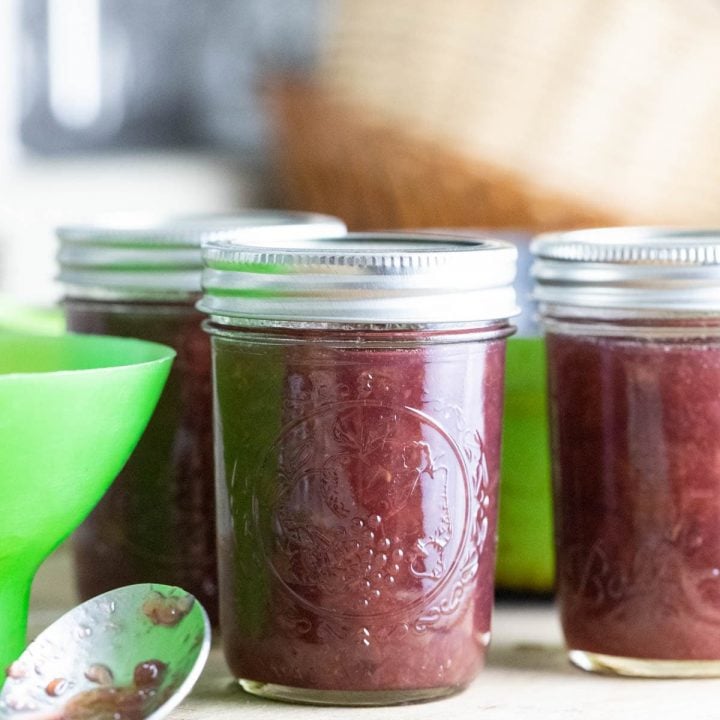
Grape Jam Without Pectin
Grape jam is sweet and delicious! This recipe uses less sugar and no store-bought pectin.
Ingredients
- 4 lb seedless grapes
- 1.7 lb sugar
- Juice of half a lemon
- 5 - 6 lemon seeds
- 2 teaspoons vanilla extract
Instructions
- Wash the grapes well and take them off the stems, add the grapes to the bowl of the food processor and pulse a few times to chop them into smaller pieces. I do this in two batches.
- Add the grapes to a deep pan and add the sugar. Turn the heat to medium-high and start cooking the grapes. It will take about 10 minutes for the mixture to start boiling. Gently boil for about 10 minutes then lower the heat to medium-low for the rest of the cooking. Make sure to stir frequently.
- Cook for an additional 15 minutes. By this point, the grapes should be soft and you can use an immersion blender or a potato masher to blend or mash the fruit.
- Add the juice of half a lemon and its seeds (about 5 or 6). Stir them in.
- Keep cooking and stirring for another hour or so. The time might change depending on how juicy the grapes you used were but it's usually around an hour to reach gel phase. Experienced jam makers will be able to recognize when the jam reaches this stage, if you are not sure, you can use the spoon test to help you.
Scoop a little bit of jam with a spoon and set it on a plate on the counter to cool for 5 minutes or so. Then, add the jam back to the pot and as it leaves the spoon you'll be able to measure how thick it is. Just take into consideration that jams thicken further in the jars as they completely cool after canning. - Once the jam is ready, remove it from the heat and add two teaspoons of vanilla extract, stir it in. Your grape jam is ready for canning!
- Fill the water bath canner with enough water to cover the jars by about an inch. Place it on the stovetop and bring the water to a gentle boil (you can do this as the jam is cooking).
- Wash the jars, lids, and bands well with hot water and soap (since we are going to process the jam for 10 minutes, there is no need to sanitize the jars).
- Use a ladle or a spoon and the canning funnel to fill the jars with the jam. Make sure to leave 1/2 inch of headspace. Use the bubble remover to scrape the inside of the jar to remove any air bubbles. Then use a damp paper towel to clean the rim of the jar before you center the lid and close the jar with the band fingertight.
- Place the jars on the rack of the canner and lower them into the boiling water. Cover the canner with its lid and process the jars in boiling water for 10 minutes if you live at an altitude under 1000 feet. Adjust processing time according to the table in the notes if you live in higher elevations.
- Once processing time is up, turn the heat off and uncover the canner. Let the jars hang out in the hot water for five minutes before you remove them. Use the jar lifters to remove the jars from the canner. Place them on a kitchen towel on the kitchen counter to cool completely overnight.
- Once the jars have cooled completely check to if they are all sealed by pressing the center of the lid. If there is no movement there this means that the jars are sealed and ready for storage. If you have a jar that didn't seal, you can keep it in the fridge and use it first or you can try to process it again.
- I like storing my jars without the bands since they tend to rust and make it hard to open the jar months later. So remove the bands and wipe your jars before placing them in the pantry. Grape jam should last for up to 18 months on the shelf.
Notes
Adjust processing time according to the table below...
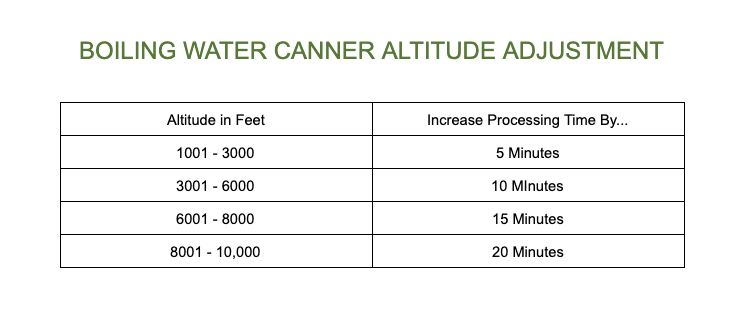
Nutrition Information:
Yield: 7 Serving Size: 1 half-pint jarAmount Per Serving: Calories: 650Total Fat: 1gSaturated Fat: 0gTrans Fat: 0gUnsaturated Fat: 0gCholesterol: 0mgSodium: 29mgCarbohydrates: 169gFiber: 5gSugar: 156gProtein: 3g

Hi! I’m Lady Lee. I help homesteaders simplify their homesteading journey while still producing a ton of food! I am a single mother of four, I was born in Israel and raised in an agricultural commune called a Kibbutz. Now I homestead in central NC.

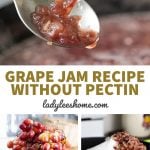
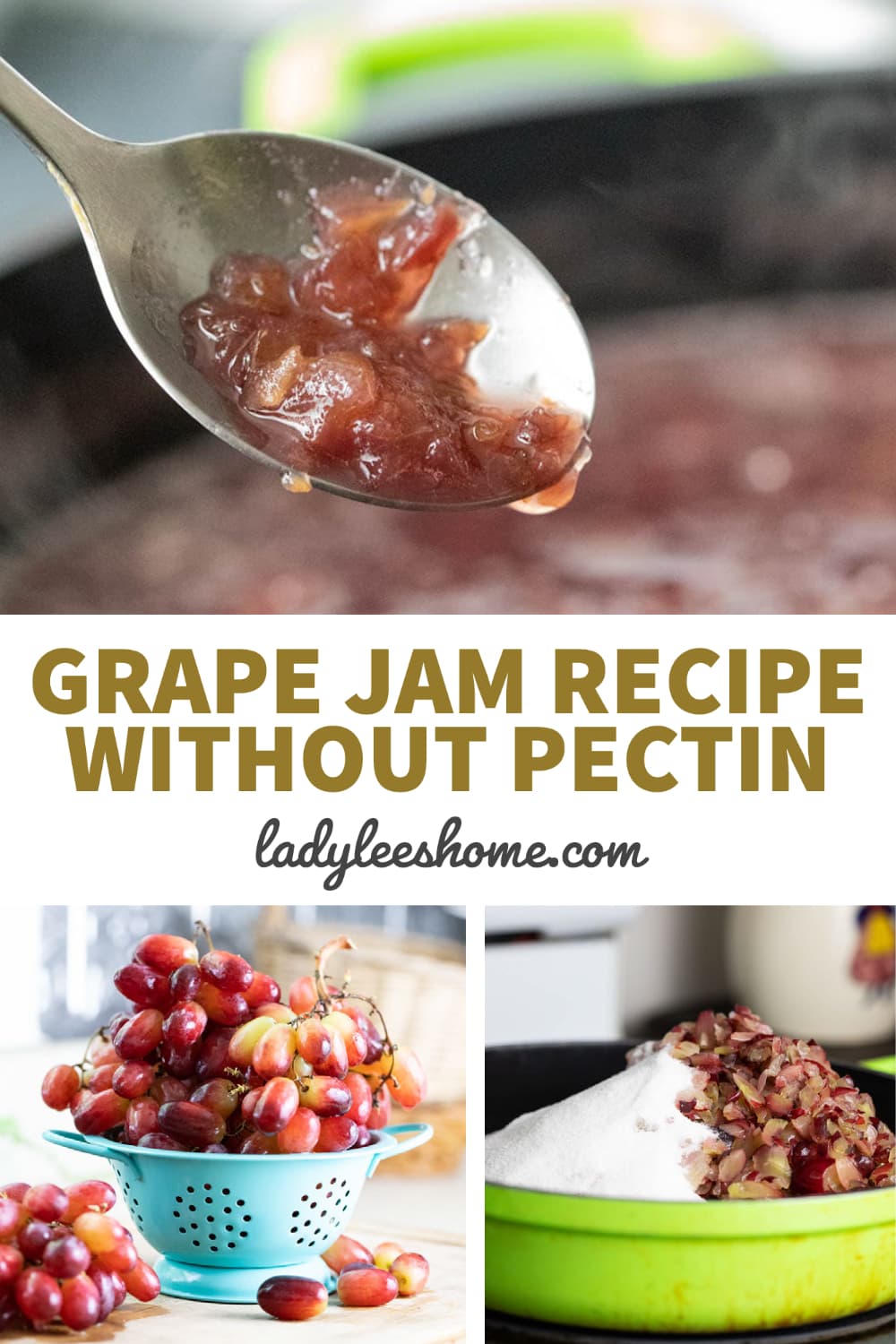
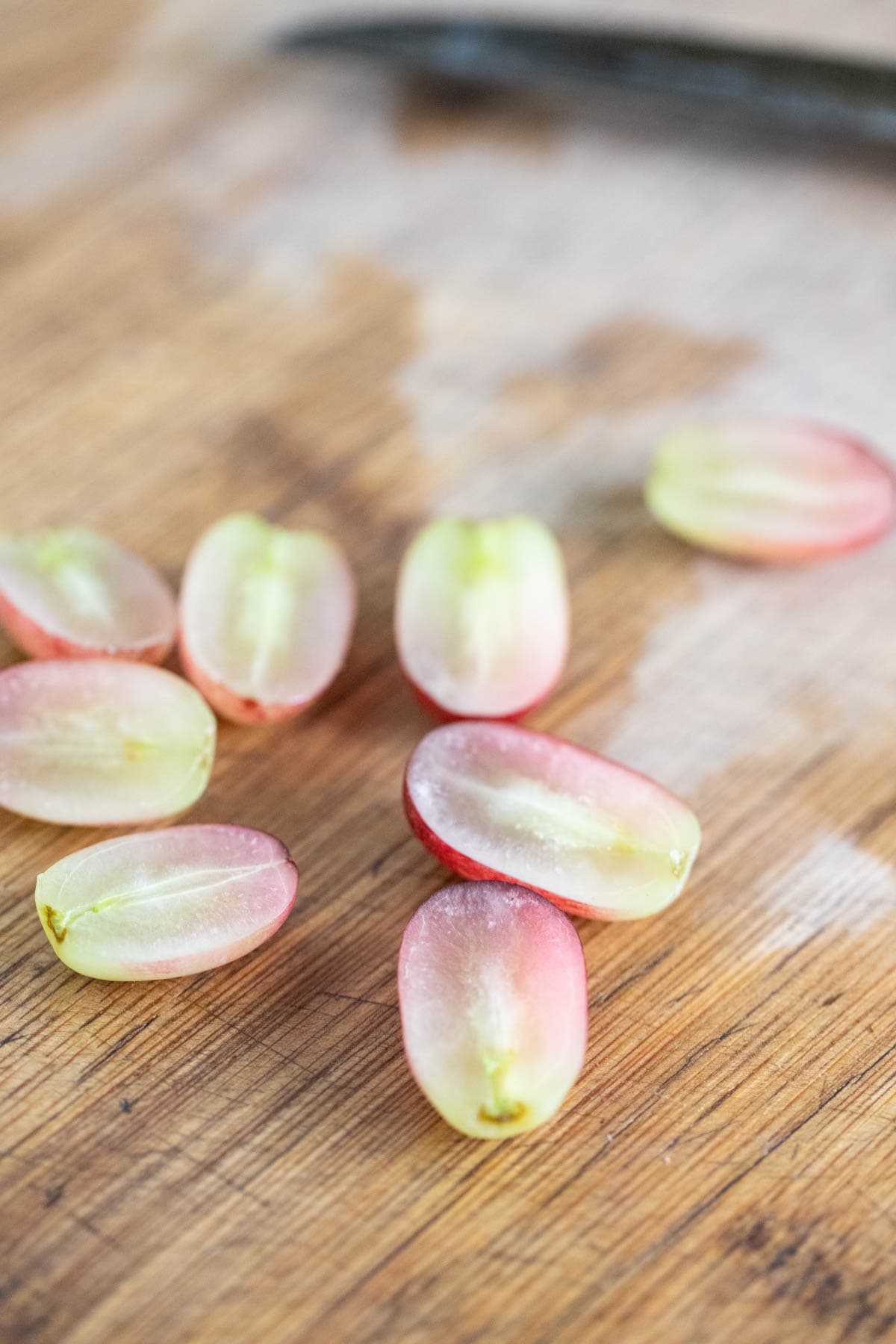

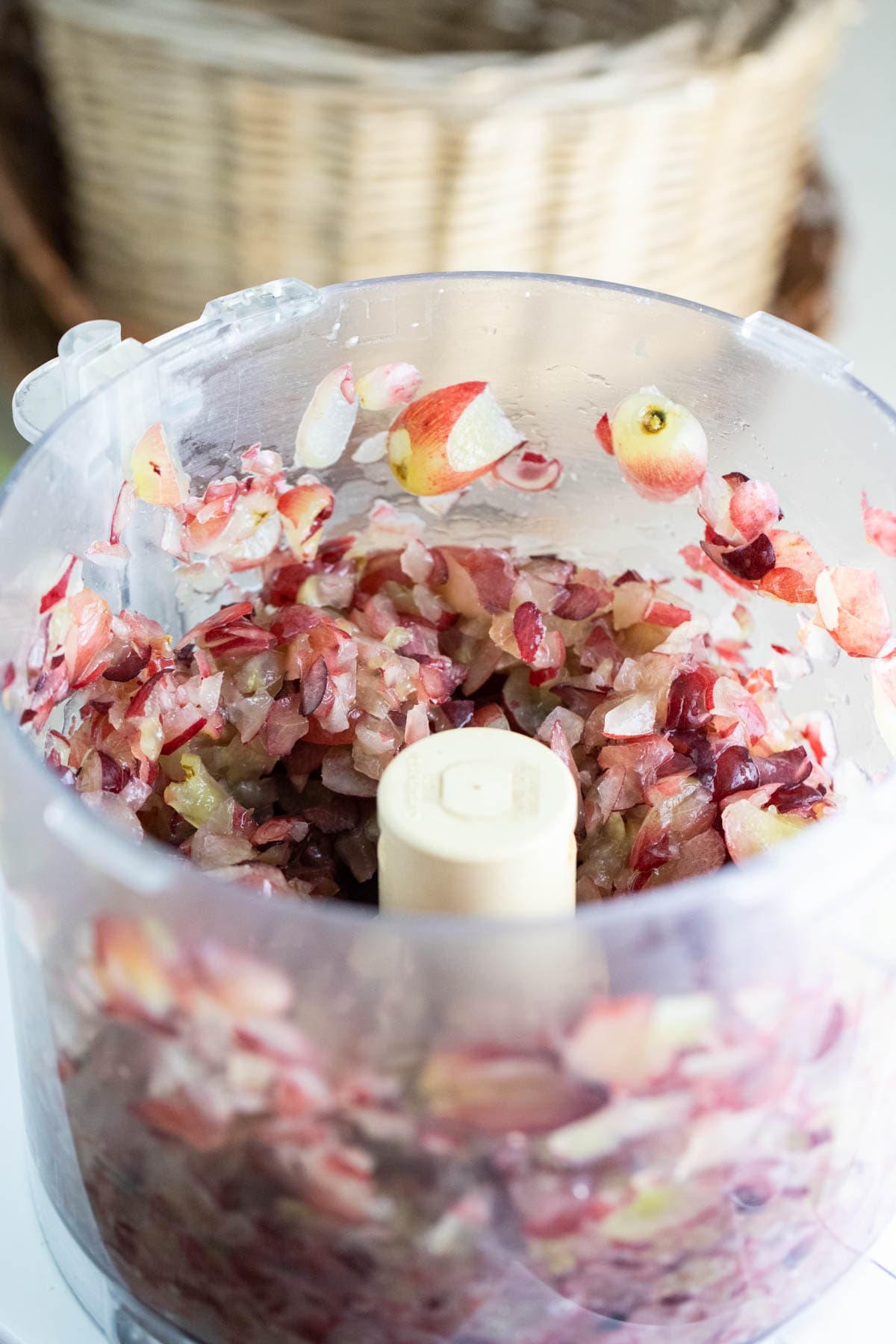
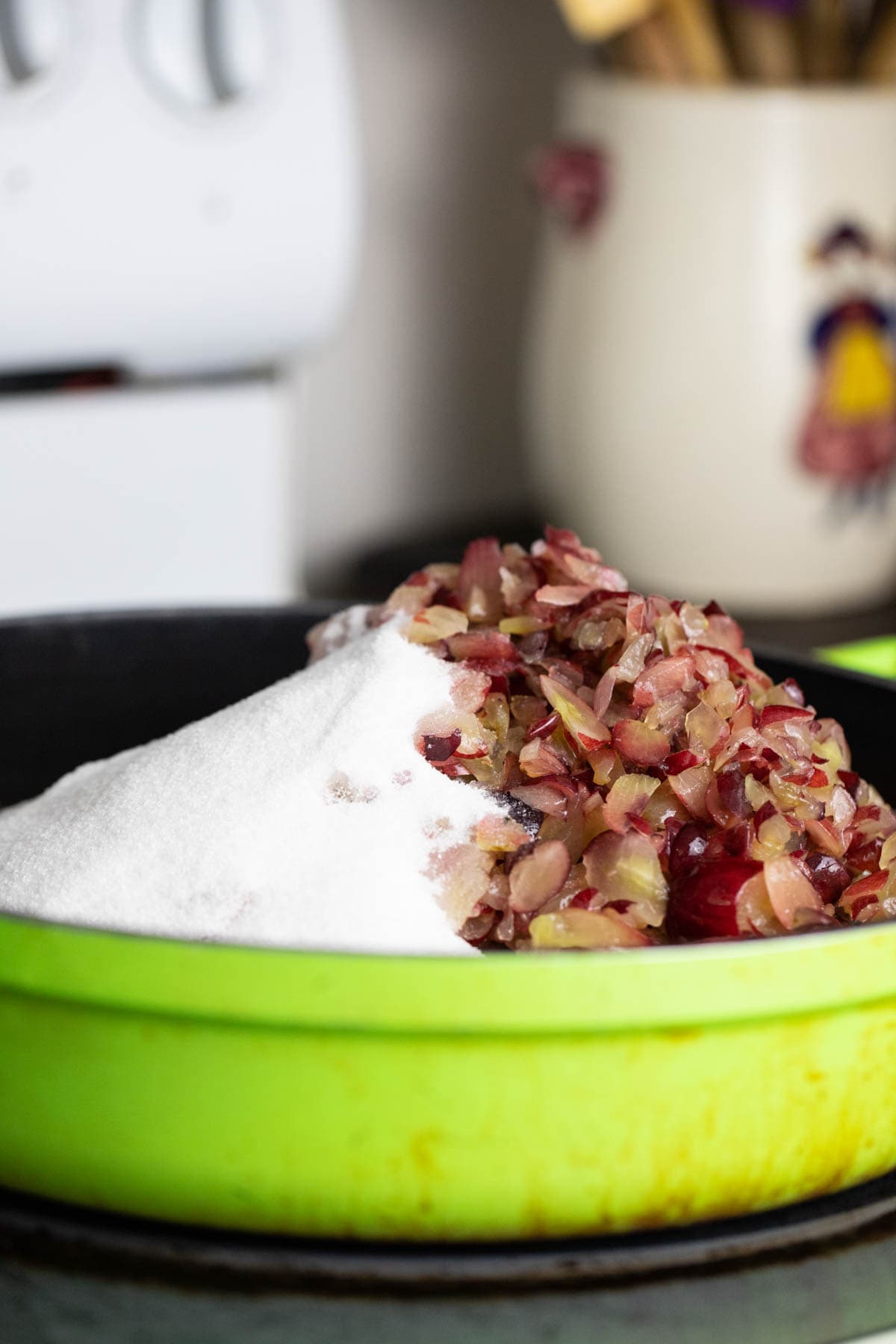
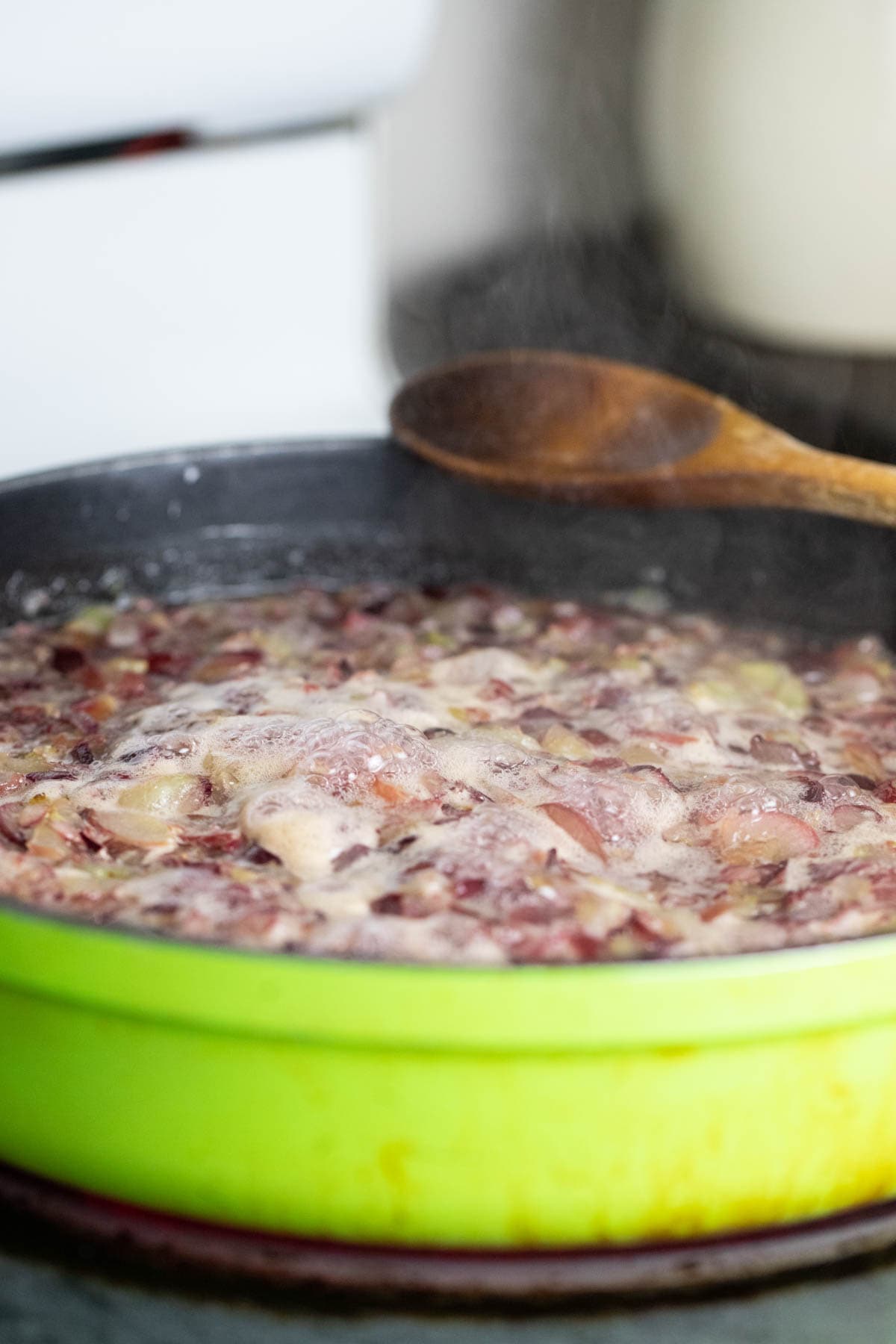
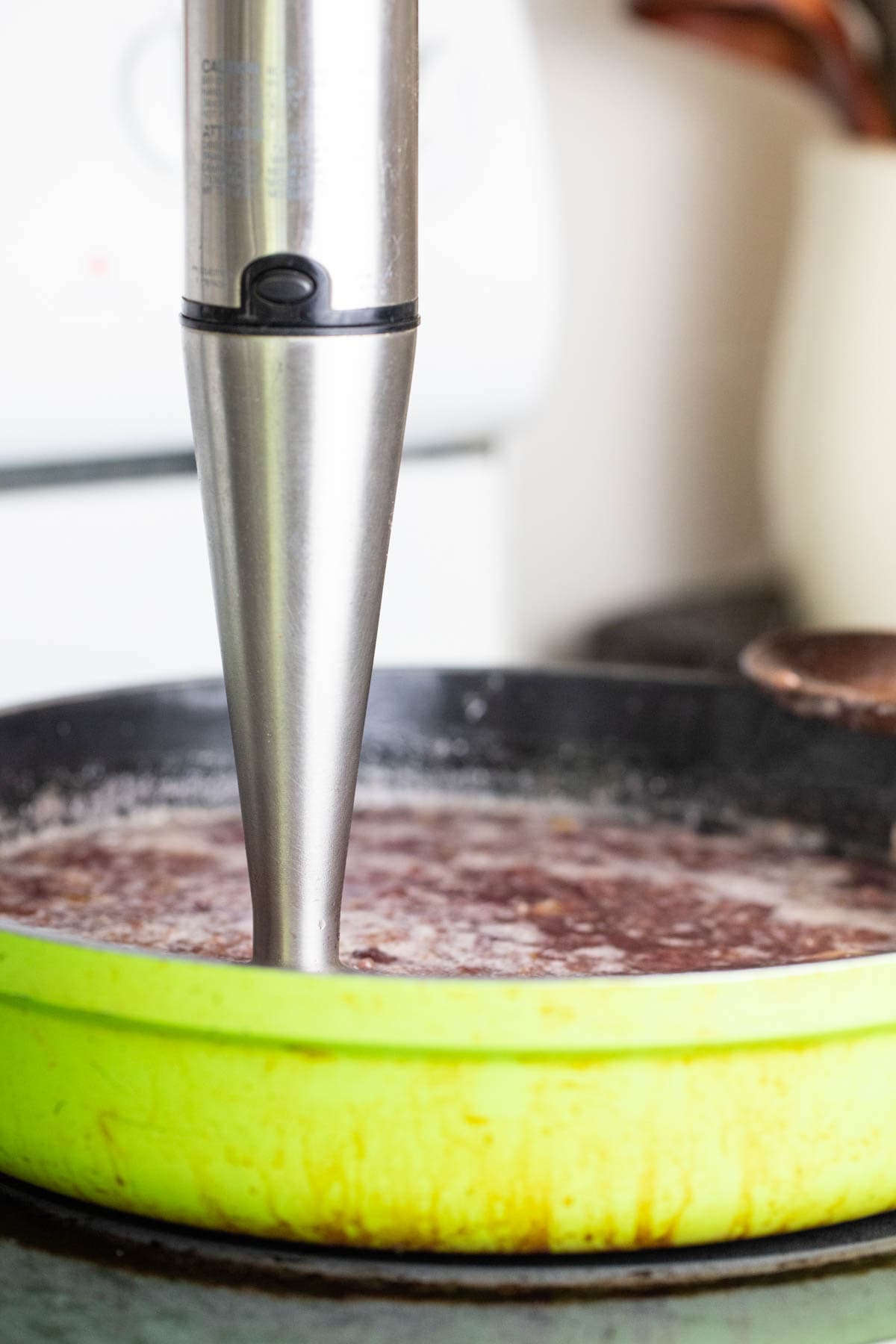
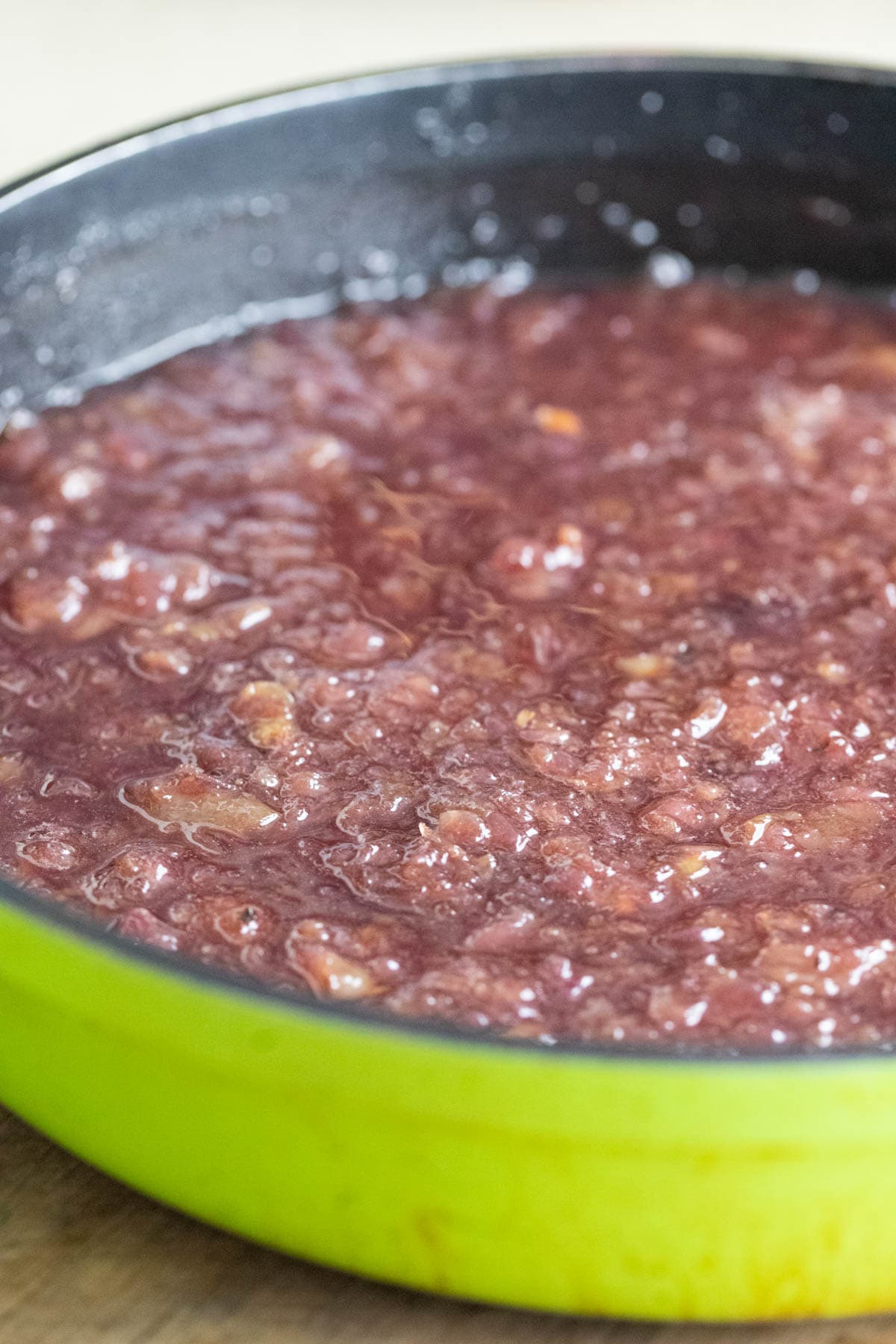

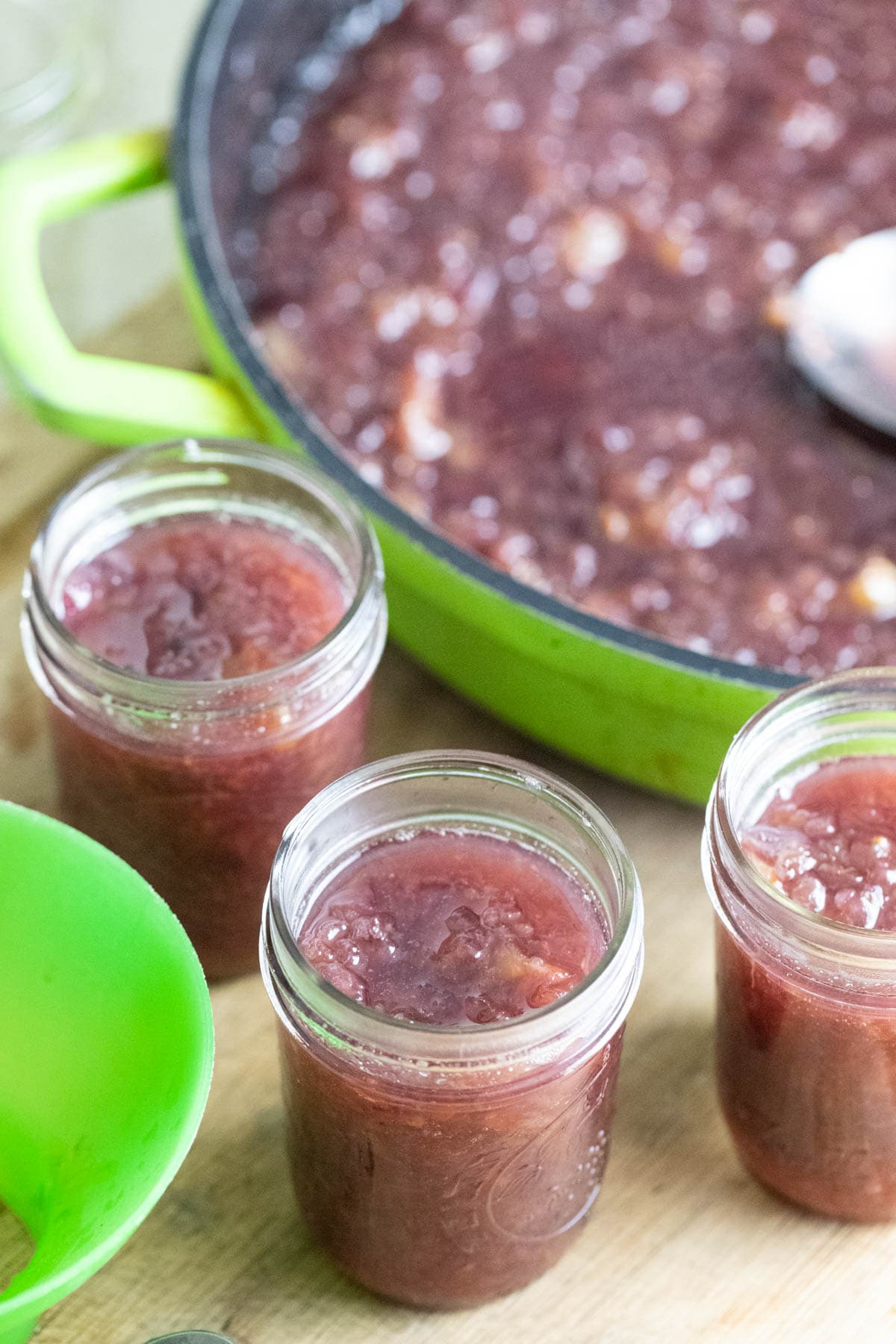
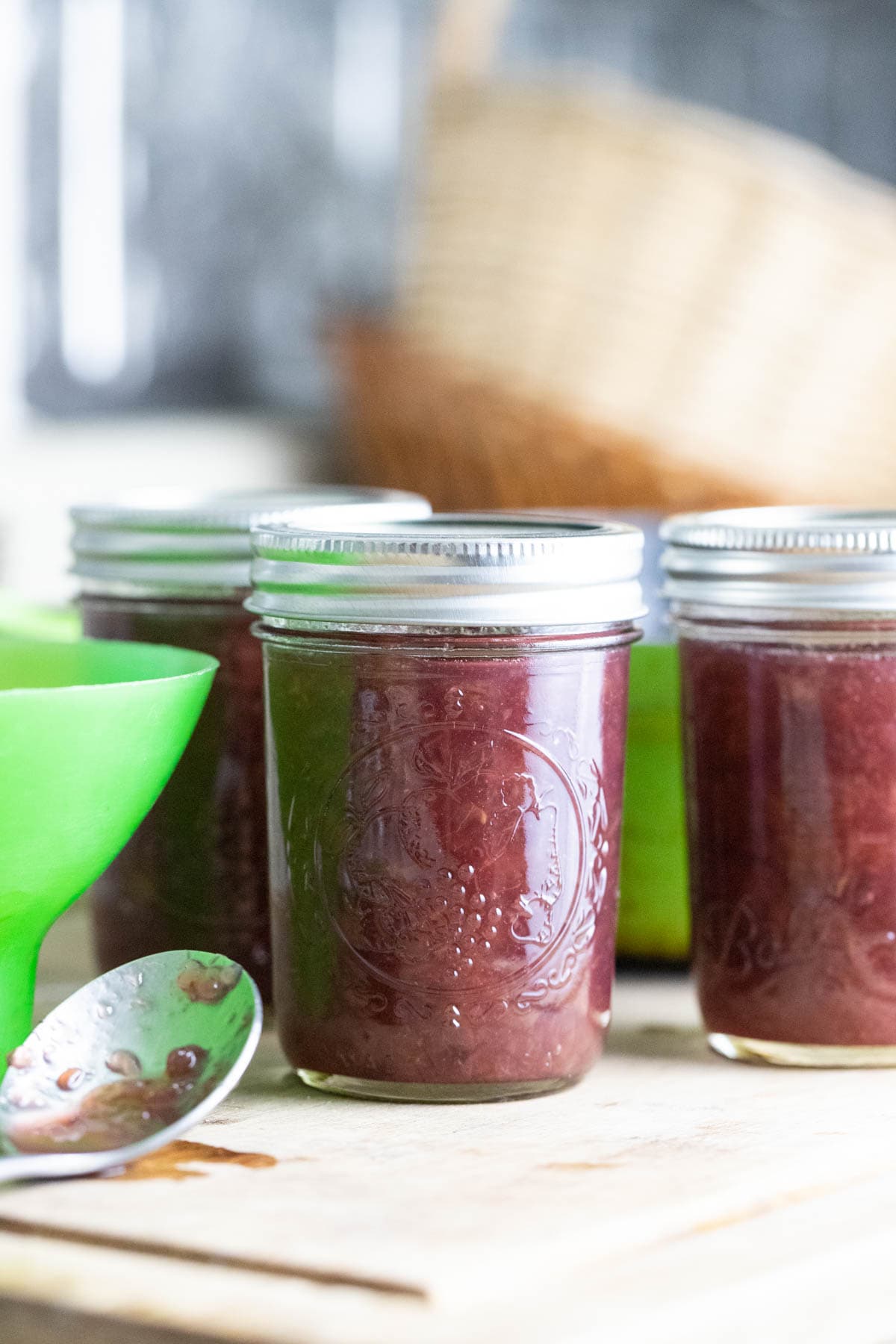
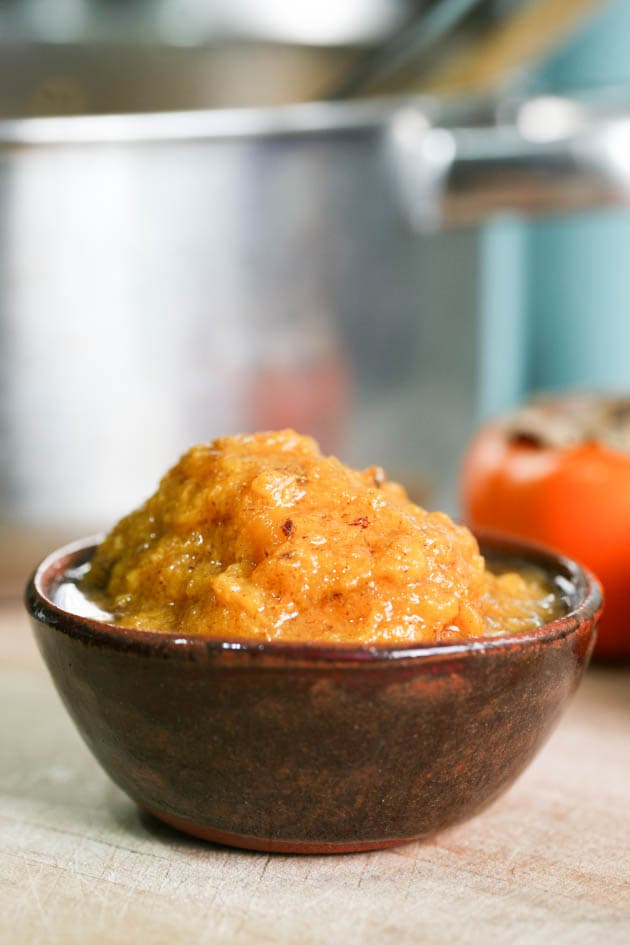
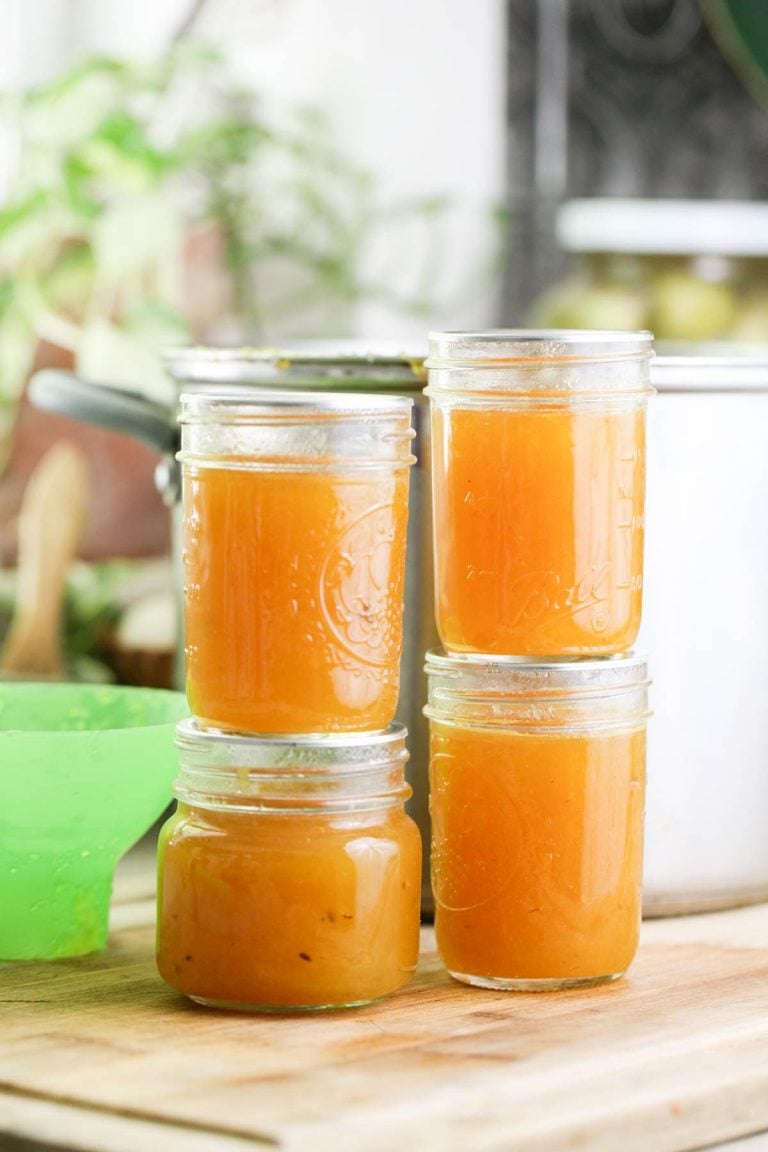

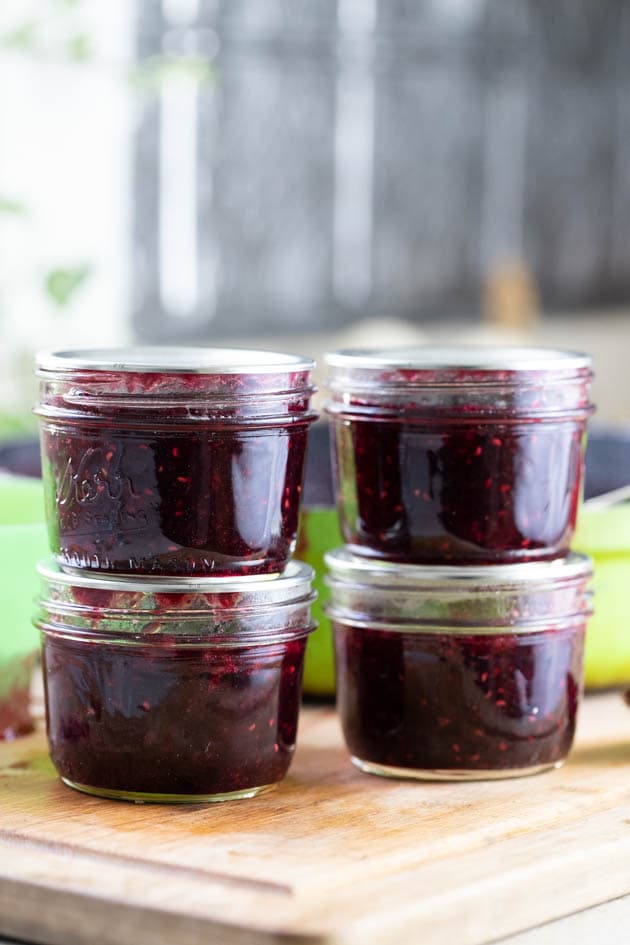
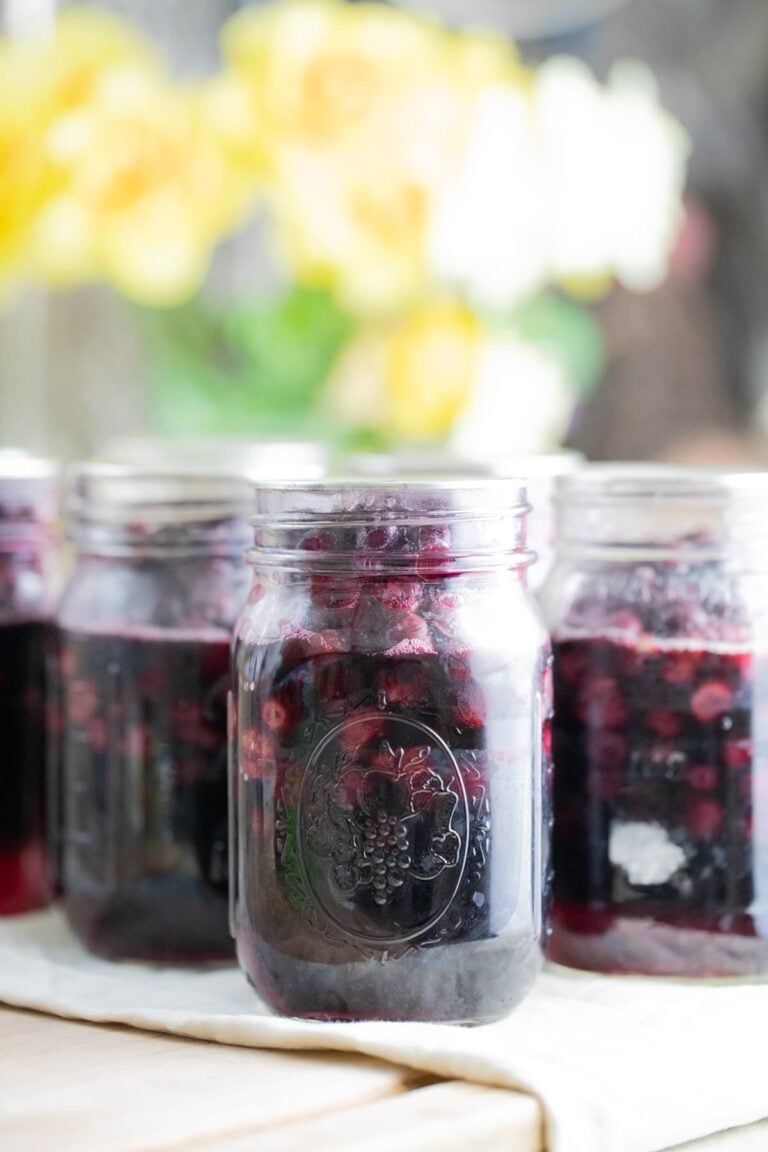
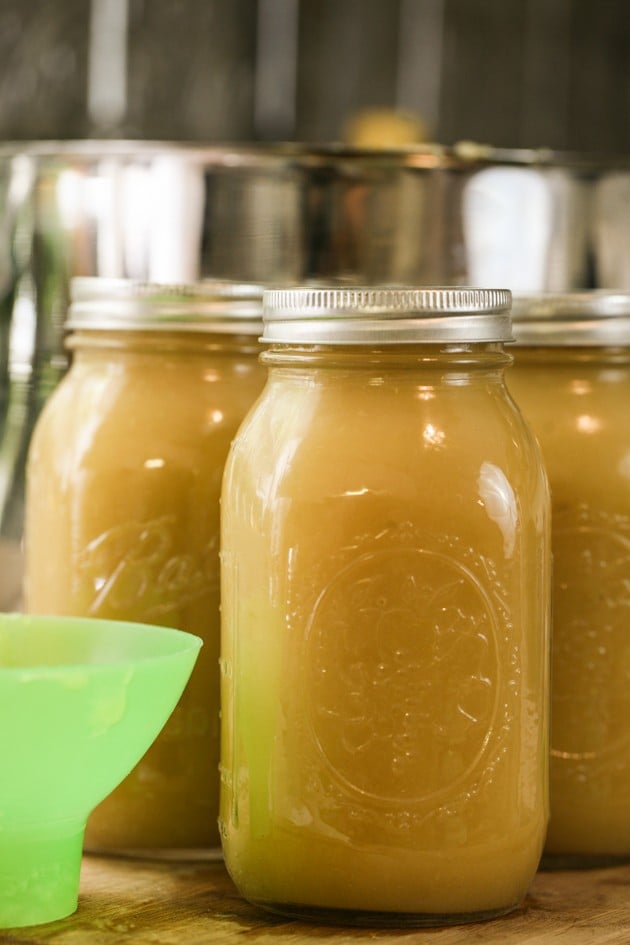
I have been checking out your jam recipes. I’m impressed. I’ve always preferred less sugar, but also always used pectin (Sure-Jel) for lower sugar.
Never heard of using lemon seed! Impressive!! I’m going to have to try it, but first I must go buy fresh lemons and as I typically save the zest, now I guess I’ll save the seeds too.
Now my question… a couple of years ago, while in CA, at my in-laws, I picked and juiced (actually I probably threw it all in the blender), then canned the result in quart jars so I could bring it home (TX) to make into jelly/jam. Any idea if this would work with your recipe? And have you ever used any sweetener besides sugar? I’m trying to get away from processed sugar. Thanks for any help and advice.
So, I’m not sure that I am understanding why you juice it… can’t you just take the fruit home fresh?
But, you can throw it in the blender, place it in a container, and freeze it. Then, take it home and use it for jam. If for some reason that works better then, yes, you can do that.
Also, check out my post on how to preserve lemon peel. They are delicious!
And, search for my honey strawberry jam recipe. That one is using honey instead of sugar and you can use that method with any fruit.
I hope this helps! Thanks for stopping by!